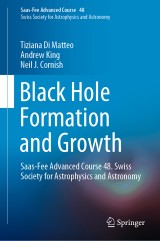Details

Black Hole Formation and Growth
Saas-Fee Advanced Course 48. Swiss Society for Astrophysics and AstronomySaas-Fee Advanced Course, Band 48
|
69,54 € |
|
| Verlag: | Springer |
| Format: | |
| Veröffentl.: | 31.10.2019 |
| ISBN/EAN: | 9783662597996 |
| Sprache: | englisch |
Dieses eBook enthält ein Wasserzeichen.
Beschreibungen
<p>The ultimate proofs that black holes exist have been obtained very recently thanks to the detection of gravitational waves from their coalescence and due to material orbiting at a distance of some gravitational radii imaged by optical interferometry or X-ray reverberation mapping. This book provides three comprehensive and up-to-date reviews covering the gravitational wave breakthrough, our understanding of accretion and feedback in supermassive black holes and the relevance of black holes for the Universe since the Big Bang. </p><p>Neil J. Cornish presents gravitational wave emission from black hole mergers and the physics of detection. Andrew King reviews the physics of accretion on to supermassive black holes and their feedback on host galaxies. Tiziana Di Matteo addresses our understanding of black hole formation at cosmic dawn, the emergence of the first quasars, black hole merging and structure formation. The topics covered by the 48th Saas-Fee Course provide a broad overview of the importance of black holes in modern astrophysics. </p>
<p> </p>
<p> </p>
Black Hole Merging and Gravitational Waves.- Supermassive Black Hole Accretion and Feedback.- Black Holes across Cosmic History: a journey through 13.8 billion years.
<p><b>Tiziana Di Matteo</b> is a Professor in the McWilliams Center for Cosmology of the Physics Department at Carnegie Mellon University, USA. She received her PhD in 1998 at Cambridge University, UK. She was a Chandra Fellow at Harvard and a junior faculty member at the Max Planck Institute for Astrophysics in Germany. Di Matteo is a theorist with expertise in both high energy astrophysics and cosmology. Her interests focus on state-of-the-art cosmological simulations of galaxy formation with special emphasis on modelling the impact of black holes on structure formation in the Universe.<b><br></b></p><p><b>Andrew King</b> is Professor of Theoretical Astrophysics at the University of Leicester and holds visiting appointments at the Universities of Amsterdam and Leiden. During his career he has been awarded a PPARC Senior Fellowship, the Gauss Professorship at the university of Goettingen, a Royal Society Wolfson Merit Award, and the RAS Eddington Medal. He is an author and co-author of several books, including Stars, a Very Short Introduction, and Accretion Power in Astrophysics. His research interests include accretion disc structure, supermassive black hole growth and feedback, active galactic nuclei, compact binary evolution, and ultraluminous X-ray sources.<br></p><p><b>Neil J. Cornish</b> is Regents Professor of Physics and Director of the eXtreme Gravity Institute at Montana State University. He completed his Ph.D. at the University of Toronto, followed by postdoctoral fellowships in Steven Hawking's group at the University of Cambridge and in David Spergel's group at Princeton University. Neil is a multiwavelength gravitational-wave astronomer, and he is a member of the Laser Interferometer Gravitational-Wave Observatory (LIGO) Scientific Collaboration, the North American Nanohertz Observatory for Gravitational Waves (NANOGrav) Collaboration, and the NASA Laser Interferometer Space Antenna (LISA) Science Study team.</p><div><br></div><p></p>
<p>The ultimate proofs that black holes exist have been obtained very recently thanks to the detection of gravitational waves from their coalescence and due to material orbiting at a distance of some gravitational radii imaged by optical interferometry or X-ray reverberation mapping. This book provides three comprehensive and up-to-date reviews covering the gravitational wave breakthrough, our understanding of accretion and feedback in supermassive black holes and the relevance of black holes for the Universe since the Big Bang. </p><p>Neil J. Cornish presents gravitational wave emission from black hole mergers and the physics of detection. Andrew King reviews the physics of accretion on to supermassive black holes and their feedback on host galaxies. Tiziana Di Matteo addresses our understanding of black hole formation at cosmic dawn, the emergence of the first quasars, black hole merging and structure formation. The topics covered by the 48th Saas-Fee Course provide a broad overview of the importance of black holes in modern astrophysics.</p>
Provides a broad overview of the importance of black holes in astrophysics by leading researcher in this field Presents a review of gravitational wave emission from black hole mergers and the physics of their detection Reviews the physics of accretion on to supermassive black holes and their feedback on host galaxies Addresses black hole formation at cosmic dawn, the emergence of the first quasars, black hole merging and structure formation

















